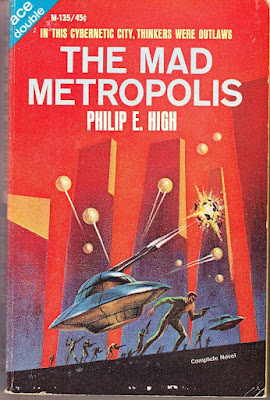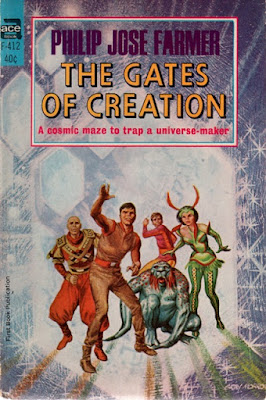The Green Brain is one of the novels that Frank Herbert published following the
release of Dune. It was first published as a novelette under the title Greenslaves in Amazing Stories in 1965. Apparently the title is a reference to the English folk song Greensleeves. It was released as a novel by Ace Books in 1966. My copy is one in a series of four Frank Herbert titles reissued by Tor in 2002, to coincide with the release of The Butlerian Jihad by Brian Herbert and Kevin J. Anderson. I read The Green Brain shortly after this publication became available and I think it is the only Frank Herbert book I didn’t like when I first read it. This second reading didn’t really alter my opinion. It’s a rather pulpish novel.
The Green Brain is set in a not too distant future in the Brazilian state of Mato Grosso. Here war is being waged to bring Brazil’s abundant insect life under control. In the so called Green Zones, all harmful insects have been eradicated in the belief that his will boost productivity and thus support a larger population. The Red Zones are yet unconquered and teeming with insects. It is the job of men such as Joao Martinho to enlarge the Green Zones. Until recently this has been going well, and there is good money to be made in the business. Signs that all is not as it should be have begun to appear, however.
To investigate the situation, a team of the International Ecological Organisation have been sent to Brazil. Lead by the Chinese Dr. Chen Lhu, they are to investigate and get the process back on track. It quickly becomes obvious that Lhu has a hidden agenda. China is one of the driving forces of the project and efforts to eradicate harmful insects have progressed furthest there. Although the Chinese preach this new way of dealing with the environment to the entire world, they are quite secretive about their own Green Zones, not allowing any outside visitors to check on their claims. People are getting suspicious, and with good reason as it turns out.
Many of Herbert’s books have an ecological theme in them; it what makes them stand out among other works published at the time. In Dune the ecology is worked intricately into the story; in The Dosadi Experiment ecology is applied to human society to explain the unusual characteristics of the population. In those books the use of this theme is not as heavy-handed as in The Green Brain, however. The reasoning behind the project to get rid of all harmful insects has a glaring and obvious error. Ecology deals with interactions between species. To take one species out of the equation requires the whole system to adjust. Given the enormous complexity of an ecosystem like the Amazon rainforest, it takes a huge amount of knowledge of the system to predict what those changes are going to be and which species will be most affected. To do it on the scale proposed in the novel is a recipe for disaster. Separating harmful from useful based on partial knowledge and hope the system won’t collapse is not a particularly smart move.
Herbert understood this; it is quite obvious from the start of the novel that the project is doomed to end in famine. Too obvious for any suspense to be left in that part of the book. To oppose this folly, Herbert uses a well-known science fiction plot device. He creates a non-human intelligence as an adversary. Based on the fact that insects procreate faster than humans and thus can evolve a lot faster, and inspired by colonial insects, an insect intelligence known as The Brain arises and takes control of the efforts to combat developments that it considers a path to the death of all life on earth. The Brain is described as highly intelligent but also immobile and completely dependent on the insects that take care of its physical needs and provide it with information of events outside its hiding place. A very vulnerable position to be in, if humans had been aware of its existence anyway. It is by far the most unlikely element in the plot.
Interestingly enough, Herbert also mentions human opposition to the project. The author never reveals whether such resistance actually exists and how widespread it is, but it is constantly accused of sabotage and re-infesting recently cleaned areas. Maybe it is used as a convenient scapegoat, but this kind of resistance makes a lot more sense to me than The Brain, and I thought it a shame Herbert didn’t go into this in more detail. With a project that is unlikely to be endorsed by any serious ecologist and a huge insect brain hiding in the jungle fighting it, my willingness to suspend disbelief broke down after the first couple of chapters. Herbert would go on to write Hellstrom’s Hive (1973), a much better novel using colonial insects as a model.
I guess I didn’t like the concept of this book, but I have to admit the way this story plays out between Martinho, Lhu and the third main character Rhinn Kelly is interesting. Events take them deep into the jungle where a complex psychological game between them develops. Although not everybody will appreciate the less than flattering description of Kelly’s services to the IEO, Herbert does manage to build the tension to great heights before the climax of the novel. The pressure heaped on Joao in particular is very well done.
Although not without its qualities, in my mind The Green Brain is the weakest of Herbert’s novels that I have read to date. He never manages to really lift it above a science fiction monster story. For an author who was reluctant to enter the field of science fiction and made many attempts to break into the mainstream fiction market in his career, it is a disappointing work. In each and every one of his novels Herbert tries to raise the level of the genre with lots of attention to the psychology of the characters as well as a good idea to support the novel. In The Green Brain he does not achieve the desired result. The combination of ecology, social insects and science fiction has potential as Herbert would later show, but in this book he did not find the right combination. (Ron Weber, Fantasy Literature)







